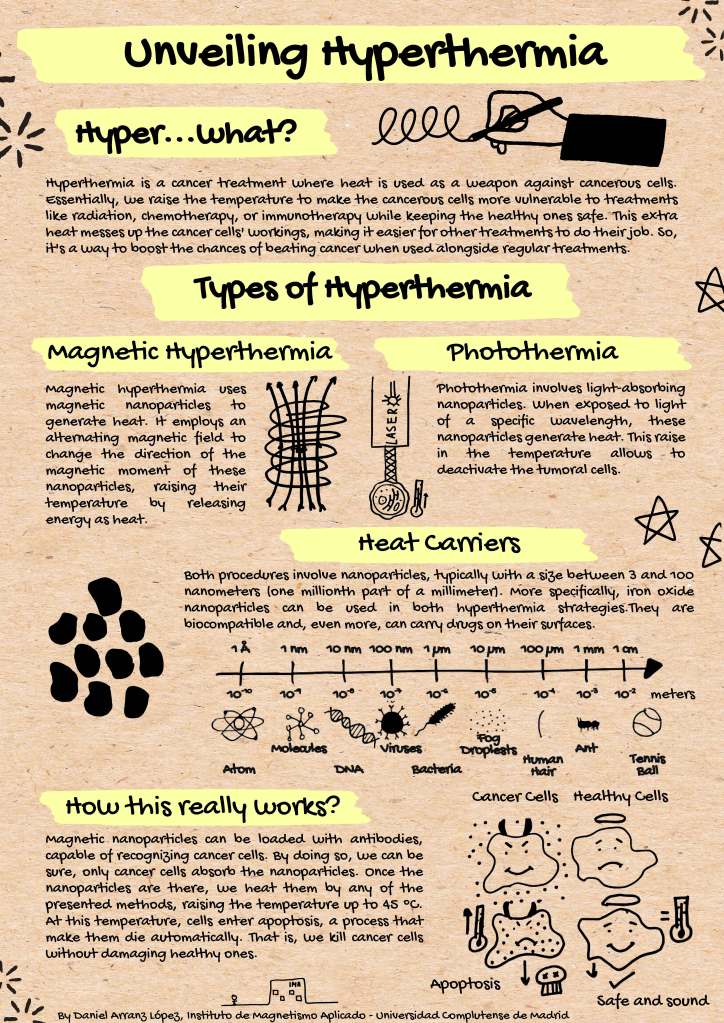días
horas minutos segundos
hasta
#ImpactingMagnetism
We have finally published the contributions that reached the final stage!
- You will have the opportunity to interact with the participants, worldwide researchers and curious citizens eager to learn science.
- Leave a comment at the bottom of this site, vote your favourite contributions 👍and subscribe our YouTube channel @cemagnetismo.
Classified Infographic Designs
Expand the dialogs to vote for your favourite infographies👍.
Dani ARANZ from Universidad Complutense de Madrid and Instituto de Magnetismo Aplicado, Spain.
Click on the image to download the infography.
(Click here to expand👆)
Unveiling Hyperthermia. Delve into hyperthermia, where magnetic and laser technologies converge to combat diseases. Discover how these non-invasive treatments harness controlled heat to precisely target and eliminate health challenges, offering new hope for patients and transforming medical care. This informative poster explores the science, benefits, and potential applications of magnetic and laser hyperthermia.
Yolanda ALVAREZ LOPEZ, from University of Oviedo, Spain.
Click on the image to zoom in.
(Click and learn more about👆)
My PhD thesis is based in the study of thermo-magneto-electric transport properties in magnetic nanowires. As my research has just already started, the main focus right now is the fabrication of such structures, along with their characterization by means of, for example, VSM or MOKE measurements, and micromagnetic simulations. These studies will allow their ulterior implementation on real devices. The impact of my research covers a wide range of fields, but focus on spintronics, due to the possibility these nanowires offer for implementing or improving magnetic storage devices, among others
Classified Videos
Expand the dialogs to vote for your favourite videos 👍.
Adrian FERNANDEZ-CALZADO from IMDEA Nanociencia, Spain.
(Don’t miss the info👆)
Adrian’s video focuses on the new technologies available today to show the importance of permanent magnets in our society. Together with the other partners in the project he is part of, they are leading this sector towards a more sustainable European future.
Ana Isabel JIMENEZ RAMIREZ from University of Oviedo, Spain.
(Click and learn about👆)
In a world where technology is a central pilar of our society, the need for faster, more powerful, and energy-efficient devices has never been more pressing. The limitations of traditional microelectronics have lead to an upsurging interest in the emergent field of Spintronics. With the potential to revolutionize the landscape of technology, Spintronics presents itself as the best alternative for the future of technology. My research focuses on the synthesis and characterization of magnetic nanowires. What makes these nanowires so captivating is their reduced dimensions, which give rise to entirely new phenomena and enhanced properties when compared to their bulk counterparts. The possibility of using magnetic nanowires in the development of revolutionary spintronic devices opens up a world of possibilities.
Alvaro PEÑA from Universidad Complutense de Madrid and Instituto de Magnetismo Aplicado, Spain.
(Click to explore more👆)
The video is related to a recent paper. It represents a novel technology for magnetoelastic resonance-based sensors and depicts relevant info, the experimental setup, results and interesting conclusions. Hopefully, the contest will give it some more diffusion and generate interest in it.
Leyre FRAILE AGUIRRE from University of Oviedo, Spain.
(Expand the information👆)
Magnetic nanoparticles are potencial candidates for the detection and quantification of molecules of interest, such as antibodies.
Eduardo ORDOQUI HUESA, from the Public University of Navarre (UPNA), Spain.
(Click and get inspired👆)
The use of multifunctional magnetic nanostructures for wastewater treatment will represent a solution for the implementation of new tertiary systems in wastewater treatment plants. Reducing the associated cost and waste generated in current treatments



Leave a comment